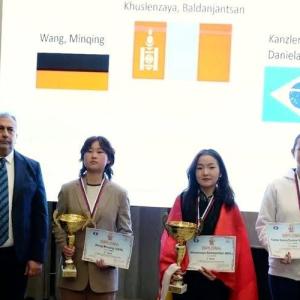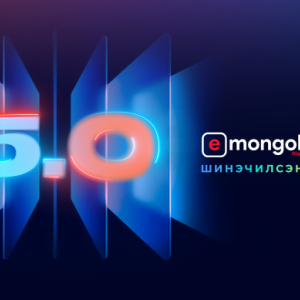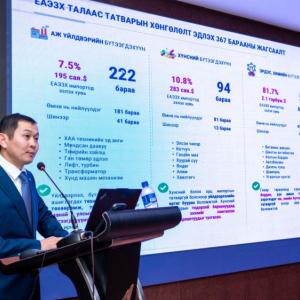S.Badral: We have a goal to create artificial intelligent robot
The Mongol Messenger
Ulaanbaatar /MONTSAME/. In the age of information technology, software developers around the world are actively seeking to create the perfect artificial intelligence. In foreign countries, artificial intelligence waiters and even taxis have been invented and successfully tested. Mongolians should not lag behind but keep up with this technological advancement. “Chimege Systems” LLC introduced its “Chimege Writer” system on October 22, which is able to convert human speech to text and text to human speech with the help of artificial intelligence. In the future, the company is intending to use this software extensively to create artificial intelligence robots. MONTSAME News Agency interviewed software developer S.Badral, the Founder of Bolorsoft LLC and the Executive Director of Chimege Systems LLC.
-Let’s start the
interview with Chimege Writer. It seems to be attracting a lot of attention
lately, and even your previous products – Bolor Telescope and Bolor Dictionary
have been very successful, haven’t they?
Our first product – Bolor Dictionary was launched in late December of 2008 which was the same year our company Bolorsoft established. Then, we officially released the product to the public in January 2009. In 2011, “Bolor Duran” – a spell checker was created and released in 2012. This was followed by the creation of Eduge system which analyzes the information on the internet.
-Now
that you have created Chimege Writer, there is a basic technology have been
created. I would like to put emphasis to the AI system that recognizes
Mongolian language rather than just a speech and text converter.
Before talking about Chimege System, I would like to let the people know that Chimege Systems and Bolorsoft are separate companies with one root. Bolorsoft is following its own path to conduct research and develop Mongolian morphology and lexicon using artificial intelligence to recognize text. On the other hand, Chimege Systems is going more into the direction of creating a Mongolian version of Siri, which can be used later to create Mongolian robot. As you mentioned in your question, Chimege Systems is a basic technology. As there is no one who does not speak, electronic devices are also climbing to the stage where they speak. In general, there is a study that 50 percent of electronic devices in the world will be able to recognize human speech by the time it is 2050. In correspond to this study, our system will be able to be compatible with almost every device.
Since the release of Chimege Writer on September 22, around 30-40 companies have already purchased it and it is also being used in court recording. Moreover, we have recently signed a contract to develop kiosks of Gerege Systems to the level where it can speak. It is also possible to be used in government service provider “E-Mongolia” mobile application. It is tiring to write long texts on mobile phones. Therefore, it will be easier if the application could recognize human speech and automatically write it down. We are working on this to offer equal opportunity to the people with certain type of disabilities.
-A
technology that recognizes and speaks Mongolian is important for kiosks at a
time when public services are becoming more electronic. Is it possible to
introduce voice recognition technology in our daily operating systems such as
Microsoft, Apple IOS and Android?
We have no objections if the developer companies of these operating systems offer us to work together. As for now, we are developing an application which we can use our technology in. Moreover, creating a Mongolian Siri is one of our goals.
-Mongolian
language has already been introduced to the voice and text recognition system
developed by Google. What makes Chimege Writer different from this?
As for our system, it has been developed on the basis of
Mongolian language. What’s more, the accuracy rate of our speech recognition
reached 97 percent, which is the same level as Google’s English language
recognition. As for Google’s Mongolian language recognition, it is at 80
percent where we can see the huge difference in the numbers. It is not easy to
develop technology to the level where it can meet people’s daily needs. Chimege
Writer recognizes both Mongolian and English at 97 percent, which means that we
have taken the quality of our software to the same level as Google’s English
recognition. The main difference can be seen at the size of the company. Google
is a tech-shark that features many different languages in their system.
Whereas, our company prioritizes the convenient solution to the complicated issues
in our language development.
-What
were the linguistic difficulties you came across while developing the system?
This question attracts a lot of attention. Mongolian language is one of the members of Altaic language family. It lacks mega researches and information resource in terms of IT development when it comes to this family of language. Secondly, the Mongolian language has a cohesive structure and the structure of a word changes a lot which makes it more challenging to work on. Thirdly, the grammars of Mongolian Cyrillic are unstable. However, we managed to overcome this challenge by identifying the original root used in Mongolian traditional script.
-Are
there any other companies that develop this type of system that features
Mongolian?
There are none in Mongolian but Google. As for other languages, there are some big players in this field including Microsoft, Facebook, Google, Amazon, IBM, Apple, Tesla, Baidu and so forth.
-I
noticed that there was a Mongolian-English-Mongolian audio translator in the
beta version of Chimege Writer. Is there a room to add more languages in the
future?
We have tested the software in English and Germany. Both languages can be recognized at the accuracy rate of 97 percent and we are planning to add more languages to the software.
-There
are many different ethnic dialects in Mongolian language. How are you dealing
with them?
As I said before, we are at 97 percent. We still have 3 percent of room for improvement, of which most of this part includes the different ethnic dialects. However, I am sure that our next big update would bring better results.
-It
must be a very useful tool for journalists and other people who keep minutes of
meetings. As you have said before, the software was sold to more than 30
companies. In terms of sectors, what kind of companies are using this?
As of today, the legal sector is the most active users. In the sense that court procedures must have a recordings according to the law. Also, Intermed Hospital is in the testing phase for hospital use. We have also established a preliminary agreement with Gerege Systems to automate electronic kiosks. It is also absolutely possible for use in education and journalism spheres.
-In
one of your speeches, you have mentioned about a system that uses human voice
to perform tests using artificial intelligence. Could you clarify this?
For me, filling out tests in the education system is not accurate. Because it gives the people an opportunity to just guess the answer with their luck. Therefore, I find it better to test one’s knowledge, judging their reading and speaking.
-Do
you mean a system where artificial intelligence listens to a person's answer
and distinguishes between right and wrong answers?
Correct. It is possible for the artificial intelligence to calculate the percentage of accuracy of the answer.
You
mentioned that you are planning to create a robot. What will the role of the
robot be and when do you think you will achieve this goal?
It is not going to be easy to create one as the
technology that can replace artificial intelligence is still in the development
phase. I assume that it will be finished within 1-2 years and I am not sure
what the exact role of the robot we are planning to create be. The one thing
clear is that it will be a Mongolian speaking virtual receptionist with an
ability to interact with human. In some countries, robots are taking over
various job vacancies such as customer assistant and receptionist.
 Ulaanbaatar
Ulaanbaatar














































































